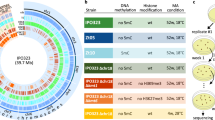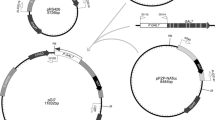Abstract
The emergence of penicilli and cleistothecia inPenicillium baarnense is governed by several genes which have been detected by mutagenesis. The morphological aspect of this fungus, as it results of the function of these genes, can be transformed by acting on physicochemical environment. Particularly, condidiogenesis occurs in genetically non-conidial strains, when the medium is modified. With conidial strains, it can be suppressed when some chemicals are added to the culture medium. Compared physiological studies of mutant and wild-type strains show that mutations affect the level of cytoplasmic ATP and the specific activities of transaminases and glutamic-acid dehydrogenase (NAD dependant).
Résumé
La formation des deux appareils de reproduction, sexuel et conidien, duPenicillium baarnense dépend de gènes détectés par mutation. L'expression de ces gènes peut être affectée par'l environnement dans lequel le Champignon se développe. En particulier, il est possible de faire apparaître des structures conidiennes chez des mutants génétiquement aconidiens en modifiant la composition du milieu de culture. L'étude physiologique des mutants induits et de la souche sauvage montre que les déficiences géniques se traduisent par des diminutions du taux d'ATP mycélien ainsi que par des modifications de l'activité des transaminases et de la glutamate-deshydrogénase liée au NAD.
Similar content being viewed by others
Bibliographie
Barratt R. W. (1963) Effect of environmental conditions on the NADP specific glutamic acid deshydrogenase inNeurospora crassa.J. Gen. Microbiol. 33:33–42
Bouvier J. (1967) Un nouvel organisme, lePenicillium baarnense,Van Beyma, pour l'étude des phénomènes de développement.C. R. Acad. Sci., Paris. (Série D) 235:1305–1308.
Bouvier J. (1968) Introduction d'un hétérothallisme non balancé chez lePenicillium baarnense Van Beyma, Ascomycète homothallique.C. R. Acad. Sci., Paris. (Série D 268:220–223.
Bouvier J. (1969) Ordre d'action des gènes et nombre de noyaux impliqués dans l'initiation et le développement des fructifications duPenicillium baarnense Van Beyma.C. R. Acad. Sci., Paris. (Serie D) 269:171–174.
Bouvier J. &Laville E. (1970) Origine et fonction des inducteurs d'états différenciés chez deux Ascomycètes.Physiol. Veg. 8:361–374.
Clutterbuck A. J. (1969) A mutational analysis of conidial development inAspergillus nidulans.Genetics. 63:317–327.
Cook R. A. &Sanwall B. D. (1969) Isocitrate-deshydrogenase (NAD specific) fromNeurospora crassa. In:Colowick, Kaplan &Lowenstein: Methods in Enzymology. XIII: 43. Acad. Press. New-York and London.
Fincham J. R. S. &Day P. R. (1963) Fungal Genetics. Blackwell Sci. Publ., Oxford: 235.
Gottlieb D. &van Etten J. L. (1964) Biochemical changes during the growth of fungi. I: Nitrogen compounds and carbohydrate changes inPenicillium atrovenetum.J. Bact. 88 :114–121.
Jicinska E. (1968) Note on study of the sporulation of fungi. Endotrophic sporulation in the genusPenicillium.Folia Microbiol. 13:401–409.
Jinks J. L. (1956) Naturally occuring cytoplasmic changes in fungi. C. R. Lab. Carlsberg.,Ser. Physiol. 26:183–203.
Kornberg A. (1955) Adenosine Phosphokinase. InColowick &Kaplan: Methods in Enzymology. II : 497. Acad. Press. New-York and London.
Laane M. M. (1969) Further cytological studies in the genusPenicillium.Hereditas, 62:153–184.
Mahoney M. &Wilkie D. (1962) Nucleocytoplasmic control of perithecial formation inAspergillus nidulans.Proc. Roy. Soc., Ser. B., 156:524–532.
Morton A. G. (1961) The induction of sporulation in mould fungi.Proc. Roy. Soc., Ser. B., 153:548–569.
Righelato R. C., Trinci A. P. J., Pirt S. J. &Peat A. (1968) The influence of maintenance energy and growth rate on the metabolic activity, morphology and conidiation ofPenicillium chrysogenum.J. Gen. Microbiol. 50:399–412.
Turian G. (1966) Morphogenesis in Ascomycetes. In:Ainsworth &Sussman: The Fungi. II: 348–352. Acad. Press. New-York and London.
Turian G. (1969) Différenciation fongique: 80–83. Masson et Cie, Paris.
Veeger C., Der Vartanian D. V. &Zeylemaker W. P. (1969) Succinate-Dehydrogenase. In:Colowick, Kaplan &Lowenstein: Methods in Enzymology, XIII: 82–83. Acad. Press. New-York and London
Author information
Authors and Affiliations
Rights and permissions
About this article
Cite this article
Parisot, D. Quelques consequences physiologiques de mutations affectant la reproduction du Penicillium baarnense van Beyma. Mycopathologia et Mycologia Applicata 46, 33–52 (1972). https://doi.org/10.1007/BF02051894
Accepted:
Issue Date:
DOI: https://doi.org/10.1007/BF02051894




